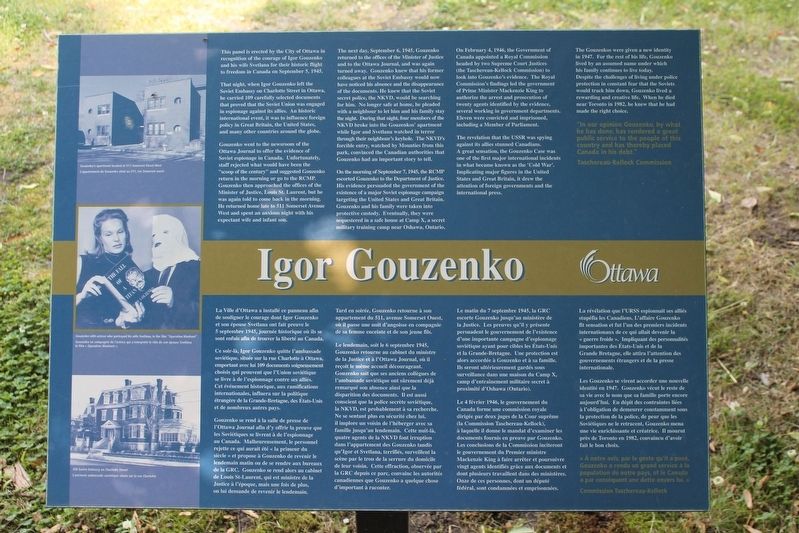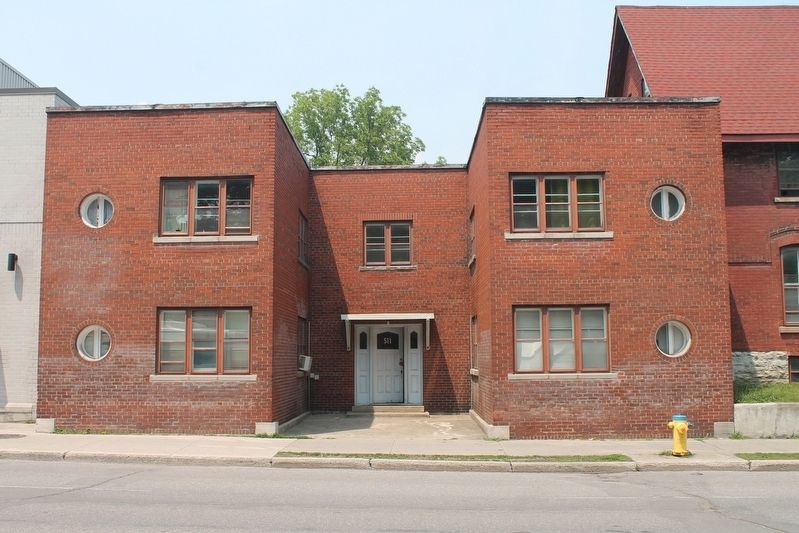Centretown in Ottawa, Ontario — Central Canada (North America)
Igor Gouzenko
That night, when Igor Gouzenko left the Soviet Embassy on Charlotte Street in Ottawa, he carried 109 carefully selected documents that proved that the Soviet Union was engaged in espionage against its allies. An historic international event, it was to influence foreign policy in Great Britain, the United States, and many other countries around the globe.
Gouzenko went to the newsroom of the Ottawa Journal to offer the evidence of Soviet espionage in Canada. Unfortunately, staff rejected what would have been the "scoop of the century" and suggested Gouzenko return in the morning or go to the RCMP. Gouzenko then approached the offices of the Minister of Justice, Louis St. Laurent, but he was again told to come back in the morning. He returned home late to 511 Somerset Avenue West and spent an anxious night with his expectant wife and infant son.
The next day, September 6, 1945, returned to the offices of the Minister of Justice and the Ottawa Journal, and again was turned away. Gouzenko knew that his former colleagues at the Soviet Embassy would now have noticed his absence and the disappearance of the documents. He knew that the Soviet secret police, the NKVD, would be searching for him. No longer safe at home, he pleaded with a neighbour to let him and his family stay the night. During that night, four members of the NKVD broke into the Gouzenkos' apartment while Igor and Svetlana watched in terror through their neighbour's keyhole. The NKVD's forcible entry, watched by the Mounties from this park, convinced the Canadian authorities that Gouzenko had an important story to tell.
On the morning of September 7, 1945, the RCMP escorted Gouzenko to the Department of Justice. His evidence persuaded the government of the existence of a major Soviet espionage campaign targeting the United States and Great Britain. Gouzenko and his family were taken into protective custody. Eventually, they were sequestered in a safe house at Camp X, a secret military training camp near Oshawa, Ontario.
On February 4, 1946, the Government of Canada appointed a Royal Commission headed by two Supreme Court Justices (the Taschereau-Kellock Commission) to look into Gouzenko's evidence. The Royal Commission's findings led the government of Prime Minister MacKenzie King to authorize the arrest and prosecution of twenty agents identified by the evidence, several working in government departments. Eleven were convicted and imprisoned, including a Member of Parliament.
The revelation that the USSR was spying against its allies stunned Canadians. A great sensation, the Gouzenko Case was one of the first major international incidents in what became what is known as the "Cold War". Implicating major figures in the United States and Great Britain, it drew the attention of foreign governments and the international press.
The Gouzenkos were given new identities in 1947. For the rest of his life, Gouzenko lived by an assumed name under which his family continues to live today. Despite the challenges of living under police protection in constant fear that the Soviets would track him down, Gouzenko lived a rewarding and creative life. When he died near Toronto in 1982, he knew he had made the right choice.
(French not transcribed)
Erected by City of Ottawa.
Topics. This historical marker is listed in this topic list: War, Cold. A significant historical date for this entry is September 5, 1945.
Location. 45° 24.804′ N, 75° 42.059′ W. Marker is in Ottawa, Ontario. It is in Centretown. Marker is on Somerset Street West, on the right when traveling east. The marker is across the street from 511 Somerset Street West on the edge of Dundonald Park. Touch for map. Marker is in this post office area: Ottawa ON K1R 5J9, Canada. Touch for directions.
Other nearby markers. At least 8 other markers are within walking distance of this marker. The Gouzenko Affair / L’Affaire Gouzenko (here, next to this marker); Christ Church Cathedral / La cathédrale Christ Church (approx. 0.8 kilometers away); John R. Booth Residence / La Résidence de John R. Booth (approx. 0.8 kilometers away); Veterans Charter / La Charte des Anciens Combattants (approx. 0.8 kilometers away); Henriette Bourque (approx. 0.8 kilometers away); St. Andrew's Presbyterian Church (approx. 0.8 kilometers away); St. Andrew's Church / L’église St. Andrew's (approx. 0.8 kilometers away); Railways and Radio Waves / Chemins de fer et ondes radio (approx. 0.8 kilometers away). Touch for a list and map of all markers in Ottawa.
Credits. This page was last revised on September 7, 2023. It was originally submitted on June 28, 2023, by Robert Rusaw of Massena, New York. This page has been viewed 45 times since then and 9 times this year. Photos: 1, 2. submitted on June 23, 2023, by Robert Rusaw of Massena, New York. • Andrew Ruppenstein was the editor who published this page.

